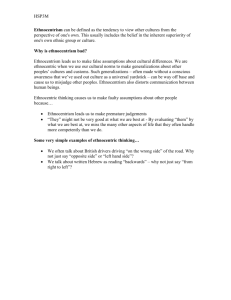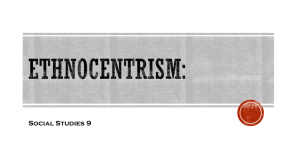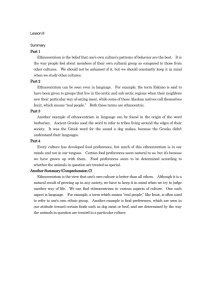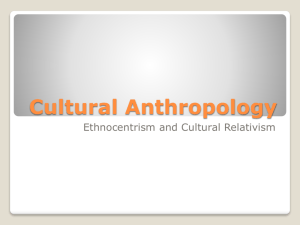Robustness of Ethnocentrism to Changes in Interpersonal Interactions Artem Kaznatcheev
advertisement
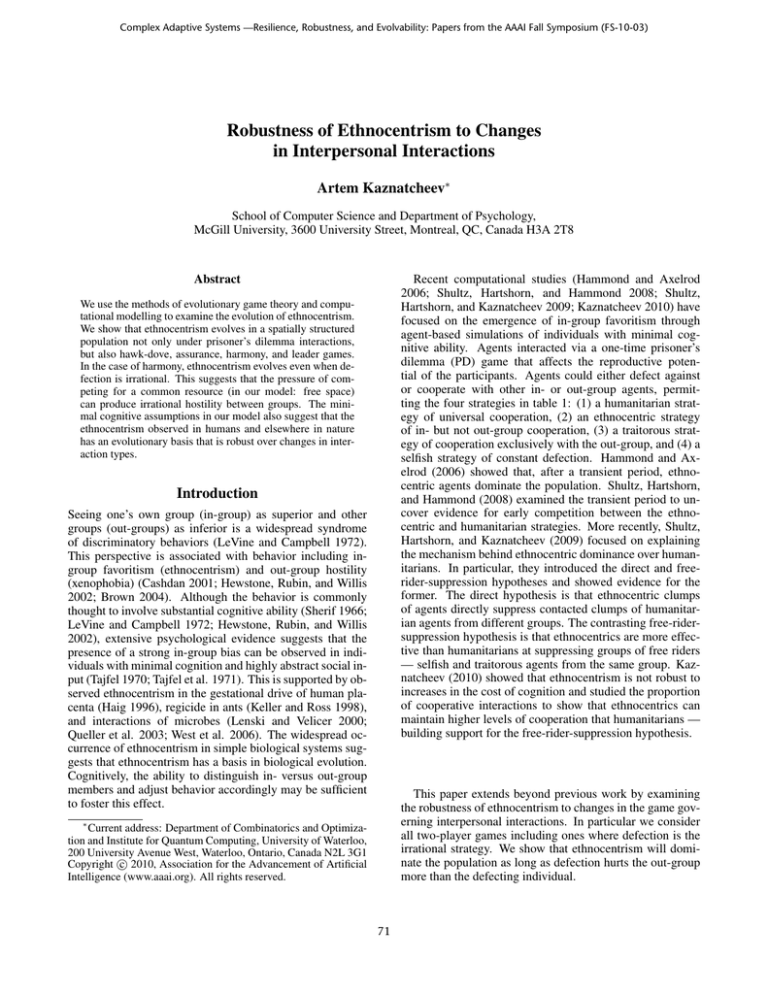
Complex Adaptive Systems —Resilience, Robustness, and Evolvability: Papers from the AAAI Fall Symposium (FS-10-03) Robustness of Ethnocentrism to Changes in Interpersonal Interactions Artem Kaznatcheev∗ School of Computer Science and Department of Psychology, McGill University, 3600 University Street, Montreal, QC, Canada H3A 2T8 Recent computational studies (Hammond and Axelrod 2006; Shultz, Hartshorn, and Hammond 2008; Shultz, Hartshorn, and Kaznatcheev 2009; Kaznatcheev 2010) have focused on the emergence of in-group favoritism through agent-based simulations of individuals with minimal cognitive ability. Agents interacted via a one-time prisoner’s dilemma (PD) game that affects the reproductive potential of the participants. Agents could either defect against or cooperate with other in- or out-group agents, permitting the four strategies in table 1: (1) a humanitarian strategy of universal cooperation, (2) an ethnocentric strategy of in- but not out-group cooperation, (3) a traitorous strategy of cooperation exclusively with the out-group, and (4) a selfish strategy of constant defection. Hammond and Axelrod (2006) showed that, after a transient period, ethnocentric agents dominate the population. Shultz, Hartshorn, and Hammond (2008) examined the transient period to uncover evidence for early competition between the ethnocentric and humanitarian strategies. More recently, Shultz, Hartshorn, and Kaznatcheev (2009) focused on explaining the mechanism behind ethnocentric dominance over humanitarians. In particular, they introduced the direct and freerider-suppression hypotheses and showed evidence for the former. The direct hypothesis is that ethnocentric clumps of agents directly suppress contacted clumps of humanitarian agents from different groups. The contrasting free-ridersuppression hypothesis is that ethnocentrics are more effective than humanitarians at suppressing groups of free riders — selfish and traitorous agents from the same group. Kaznatcheev (2010) showed that ethnocentrism is not robust to increases in the cost of cognition and studied the proportion of cooperative interactions to show that ethnocentrics can maintain higher levels of cooperation that humanitarians — building support for the free-rider-suppression hypothesis. Abstract We use the methods of evolutionary game theory and computational modelling to examine the evolution of ethnocentrism. We show that ethnocentrism evolves in a spatially structured population not only under prisoner’s dilemma interactions, but also hawk-dove, assurance, harmony, and leader games. In the case of harmony, ethnocentrism evolves even when defection is irrational. This suggests that the pressure of competing for a common resource (in our model: free space) can produce irrational hostility between groups. The minimal cognitive assumptions in our model also suggest that the ethnocentrism observed in humans and elsewhere in nature has an evolutionary basis that is robust over changes in interaction types. Introduction Seeing one’s own group (in-group) as superior and other groups (out-groups) as inferior is a widespread syndrome of discriminatory behaviors (LeVine and Campbell 1972). This perspective is associated with behavior including ingroup favoritism (ethnocentrism) and out-group hostility (xenophobia) (Cashdan 2001; Hewstone, Rubin, and Willis 2002; Brown 2004). Although the behavior is commonly thought to involve substantial cognitive ability (Sherif 1966; LeVine and Campbell 1972; Hewstone, Rubin, and Willis 2002), extensive psychological evidence suggests that the presence of a strong in-group bias can be observed in individuals with minimal cognition and highly abstract social input (Tajfel 1970; Tajfel et al. 1971). This is supported by observed ethnocentrism in the gestational drive of human placenta (Haig 1996), regicide in ants (Keller and Ross 1998), and interactions of microbes (Lenski and Velicer 2000; Queller et al. 2003; West et al. 2006). The widespread occurrence of ethnocentrism in simple biological systems suggests that ethnocentrism has a basis in biological evolution. Cognitively, the ability to distinguish in- versus out-group members and adjust behavior accordingly may be sufficient to foster this effect. This paper extends beyond previous work by examining the robustness of ethnocentrism to changes in the game governing interpersonal interactions. In particular we consider all two-player games including ones where defection is the irrational strategy. We show that ethnocentrism will dominate the population as long as defection hurts the out-group more than the defecting individual. ∗ Current address: Department of Combinatorics and Optimization and Institute for Quantum Computing, University of Waterloo, 200 University Avenue West, Waterloo, Ontario, Canada N2L 3G1 c 2010, Association for the Advancement of Artificial Copyright Intelligence (www.aaai.org). All rights reserved. 71 relaxed toward a HD game. From a purely theoretical perspective, it is important to study both PD and HD because spatial effects can be qualitatively different (sometimes even opposite) between the two (Killingback and Doebeli 1996; Hauert and Doebeli 2004). In social sciences and law, McAdams (2009) argues that games like HD, assurance, and battle of the sexes — although under-studied — are extremely important because they can be used to model bargaining, constitutional and international law, democratic stability, standard-setting, and low-stakes disputes. From a game-theoretic perspective we can analyze when cooperation and defection is classically rational (and thus dominant in an inviscid population) and when we have fixed distributions of cooperation and defection. If V < 1 then cooperation is rational (and evolutionarily stable (ESS)) and if U < 0 then defection is rational (and ESS); otherwise both pure strategies are irrational. In the case that (i) U > 0 and V > 1, or (ii) U < 0 and V < 1, there is an internal fixed point at the proportion of cooperation: Figure 1: Partition of the U -V plane according to the different rank ordering of R, S, T and P . Particularly notable games are provided with names. Note that ‘BotS’ stands for Battle of the Sexes. p∗ = U . U + (V − 1) (2) In case (i) the fixed point is stable and thus an inviscid population will converge to it, and in case (ii) the fixed point is unstable and the population will bifurcate depending on if the initial proportion of cooperators is above or below p∗ . In this paper we will sample from all 12 types of games given in figure 1. Game Space In our model, each individual (player 1) engages in a twoplayer game with an adjacent individual (player 2). In this game, the player choses between two strategies: to cooperate (C) or defect (D). The payoff matrix for player 1 given the choices of both players: R S , T P Model Our model and the Hammond and Axelrod (2006) model it is based on expand beyond random interactions. Instead of randomly choosing interaction pairs, agents populate a toroidal square lattice (50 by 50 cells) and interact with their four adjacent neighbors. Each individual is simple, only perceiving whether it shares a common tag with neighbors (from a total of 8 tags), allowing for two interaction strategies: an in-group (igs) and an out-group (ogs) strategy. The four strategies are summarized in table 1. The outcomes of the two-player game are added to the agents potential to reproduce (ptr, which is reset to .16 at the start of each cycle). At the end of a cycle, each agent has a chance equal to its ptr to clone itself (with a constant mutation rate (.005)) and a constant probability (.15) of dying. If an agent expires then its location is vacated until habitation by a new agent. Regardless of the agent’s survival, if the agent cloned itself the child is placed in one empty cell adjacent to the parent (potentially including the parent’s cell if the parent expired after cloning itself). To start the world, and if the population ever reaches zero, the world is seeded with 160 individuals distributed randomly across the torus and uniformly across the 32 strains (8 possible tags, 2 possible igs, 2 possible ogs). The simulation runs for 3000 cycles. The key variable between simulations is the game, as characterized by the matrix G in equation 1. In particular, we vary U and V across all 12 games with a resolution of 0.5 and across the harmony game with a resolution of 0.25. We fix the strength of selection at 0.02, yielding a change where R is the payoff for both players choosing C, P for mutual D and for C against D the first player receives S and the second T . Without loss of generality, we can assume that R > P (rename C and D in the other case) and normalize by subtracting any constant offset and choosing our units, to get the canonical matrix: 1 U G= (1) V 0 This allows us to plot all two-player symmetric games in the U -V plane as shown in figure 1. The different possible ordering of R, S, T, P divide the plane into 12 regions with each region representing a certain type of game. Some of the popular games are marked with their names. The popular Prisoner’s dilemma game (Rapoport and Chammah 1965; Thrivers 1971; Axelrod and Hamilton 1981) is just one of many symmetric two-player games. The difficulty of identifying even the relative rankings of payoffs in nature (Milinski et al. 1997; Turner and Chao 1999) emphasises the importantce of testing the robustness of results across various types of games. For instance, Heinsohn and Packer (1995) showed that intergroup conflicts between lions is better modelled by Hawk-Dove (HD) games than by PD. Clutton-Brock (2002) provided further examples of games in nature where assumptions of PD must be 72 Name Humanitarian Ethnocentric Traitorous Selfish igs C C D D ogs C D C D Table 1: The four possible strategies. The igs column correspond to the in-group strategy, ogs to out-group strategy. in ptr for an agent of strategy i interacting with an agent of strategy j: Δptr = 0.02Gij (3) As an example, consider a PD game with U = −0.5 and V = 1.5. Suppose that a cooperative agent is surrounded by one cooperator, two defectors, and one empty site. In that case, they payoff for the agent will be: ptr = 0.16 + 1 · 0.02 · 1 + 2 · 0.02 · (−0.5) = 0.16 (a) All games Where the first summand is from the default ptr, the second is from one interaction with a cooperator with strength of selection 0.02 and the second is from two interactions with defectors with the same strength of selection. The main recorded observable during the simulation is the distribution of agents by strategy. When comparing simulations with different games we take the mean data from the last 1000 cycles, during which dynamics stabilize. To account for the stochastic nature of our model, all results are presented as an average over 30 worlds (a world is a single instance of the simulation with specific parameter setting and initial random seed). Results Our primary results are presented in figure 2. Figure 2 contains data from 1950 worlds over 65 values of U and V with 30 worlds per value. Circles are filled in proportion to the amount of ethnocentrics in the final population. Figure 2a shows all 12 games with U varying between −2 and 1 in intervals of 0.5 and V varying between −1 and 2 in intervals of 0.5. In figure 2b we present a more detailed view of the harmony games (games #6 and #7 in figure 1) with U and V ranging between 0 and 1 in steps of 0.25. It is clear from figure 2b that ethnocentrism is dominant across the spectrum of games as long as V > U . When V = U we see a quick phase transition from nearly full ethnocentrism to none. Figure 2b further clarifies the transitions and shows that ethnocentrism is dominant even in the harmony game. When V < U cooperation becomes so dominant that humanitarians quickly take over the whole population reducing the proportion of ethnocentrics to nearly zero. As an example of the phase transition we include two games in figure 3. Similar to Shultz, Hartshorn, and Hammond (2008) in figure 3a we see a transient competition from humanitarians followed by ethnocentric dominance. Analogous to the results of Shultz, Hartshorn, and Kaznatcheev (2009) the bifurcation between ethnocentrics and (b) Harmony game Figure 2: Proportion of ethnocentric agents by game. The game is parametrized by U and V as in equation 1. At each simulated value the radius of the colored in black circle is proportional the proportion of ethnocentrics over the last 1000 cycles. Thus, an empty circle corresponds to no ethnocentrics and a full circle is a population that is fully ethnocentric. A partially filled circle (such as the ones on the line V = U ) correspond to a mixed population that contains a significant number of ethnocentric and other agents. The data for each point is from averaging 30 simulations with the game given by the U -V coordinates. Figure (a) shows all 12 games with a resolution of 0.5, and figure (b) shows a close up of the harmony game with a resolution of 0.25 73 mond and Axelrod 2006; Shultz, Hartshorn, and Hammond 2008; Shultz, Hartshorn, and Kaznatcheev 2009) suggest that ethnocentrism in viscous populations is robust against variation in the payoff matrix. This implies that systems in variable environments — operating under different games — can all evolve ethnocentric behavior. The qualitative agreement with Shultz, Hartshorn, and Kaznatcheev (2009) on the coincidence of the ethnocentric-humanitarian bifurcation and world saturation suggests that ethnocentric agents dominate in part due to their increased ability to win space at inter-group borders. In particular, when V > U defecting hurts the partner more than the defector and thus is advantageous when competing for limited resources (free space) for one’s group. The most surprising results is ethnocentric dominance in the assurance (#5), harmony (#6), and game #9 (see figure 1). In these games, cooperation is a rational strategy and yet defection dominates for out-group interactions. In the case of harmony (0 < U < V < 1) cooperation is the only dominant strategy. This shows that the out-group interactions cannot be approximated as an inviscid interaction between representatives of the group. When previous researchers observed the evolution of ethnocentrism under PD, they actually showed that a viscous population facilitates in-group cooperation. The results for the the assurance, harmony, and game #9 suggest that the converse is also true — a viscous population facilitates out-group defection or hostility. The evolution of ethnocentrism in populations of cognitively simple agents is a double-edged sword: it can cause unexpected cooperative behavior, but also irrational hostility. (a) U = 0, V = 0.5 Acknowledgements The author would like to thank Thomas R. Shultz and an anonymous reviewer for helpful comments. (b) U = 0.5, V = 0 References Figure 3: Mean number of agents of various strategies vs. evolutionary cycle. The lines represent the number of agents of each strategy: blue — humanitarian; green — ethnocentric; yellow — traitorous; red — selfish. The width of the line corresponds to standard error from averaging 30 different worlds. The two figures correspond to different games given by equation 1. Figure 3a shows data from a game on the border of assurance and harmony (games #5 and #6 in figure 1) with U = 0 and V = 0.5. Figure 3b shows data from a game with U = 0.5 and V = 0. Axelrod, R., and Hamilton, W. D. 1981. The evolution of cooperation. Science 211:1390–1396. Brown, D. E. 2004. Human universals, human nature, and human culture. Daedalus 133 (4):47–54. Cashdan, E. 2001. Ethnocentrism and xenophobia: A crosscultural study. Current Anthropology 42:760–765. Clutton-Brock, T. 2002. Breeding together: Kin selection and mutualism in cooperative vertebrates. Science 296:69– 72. Haig, D. 1996. Gestational drive and the green-bearded placenta. Proc. Natl. Acad. Sci. USA 93:6547–6551. Hammond, R., and Axelrod, R. 2006. The evolution of ethnocentrism. Journal of Conflict Resolution 50:926–936. Hauert, C., and Doebeli, M. 2004. Spatial structure often inhibits the evolution of cooperation in the snowdrift game. Nature 428:643–646. Heinsohn, R., and Packer, C. 1995. Complex cooperative strategies in group-territorial african lions. Science 269:1260–1262. humanitarians coincides with world saturation. In figure 3a we have V > U so ethnocentrism dominates after the bifurcation and in figure 3b we have V < U — humanitarians dominate after the bifurcation. Discussion Our results clearly show a phase transition from ethnocentric dominance (when V > U ) to humanitarian dominance (when V < U ). The close qualitative agreement between all games that have V > U with earlier results for PD (Ham- 74 Hewstone, M.; Rubin, M.; and Willis, H. 2002. Intergroup bias. Annual Review of Psychology 53:575–604. Kaznatcheev, A. 2010. The cognitive cost of ethnocentrism. In Ohlsson, S., and Catrambone, R., eds., Proceedings of the 32nd annual conference of the cognitive science society. Austin, TX: Cognitive Science Society. Keller, L., and Ross, K. 1998. Selfish genes: a green beard in the red fire ant. Nature 394:573–575. Killingback, T., and Doebeli, M. 1996. Spatial evolutionary game theory: Hawks and doves revisited. Proceedings of the Royal Society B 263:1135–1144. Lenski, R., and Velicer, G. 2000. Games microbes play. Selection 1:51–57. LeVine, R. A., and Campbell, D. T. 1972. Ethnocentrism. New York: John Wiley. McAdams, R. H. 2009. Beyond the prisoner’s dilemma: Coordination, game theory, and law. Southern California Law Review 82. Milinski, M.; Luthi, J.; Eggler, R.; and Parker, G. 1997. Cooperation under predation risk: experiments on costs and benefits. Proceedings of the Royal Society B 264:831–837. Queller, D.; Ponte, E.; Bozzaro, S.; and Strassmann, J. 2003. Single-gene greenbeard effects in the social amoeba Dictyostelium discoideum. Science 299:105–106. Rapoport, A., and Chammah, M. 1965. Prisoner’s Dilemma: A Study in Conflict and Cooperation. Ann Arbor, MI: The University of Michigan Press. Sherif, M. 1966. Group conflict and co-operation: Their social psychology. London: Routledge Kegan Paul. Shultz, T. R.; Hartshorn, M.; and Hammond, R. A. 2008. Stages in the evolution of ethnocentrism. In Love, B.; McRae, K.; and V.M., S., eds., Proceedings of the 30th annual conference of the cognitive science society, 1244–1249. Austin, TX: Cognitive Science Society. Shultz, T. R.; Hartshorn, M.; and Kaznatcheev, A. 2009. Why is ethnocentrism more common than humanitarianism? In Taatgen, N., and van Rijn, H., eds., Proceedings of the 31st annual conference of the cognitive science society, 2100–2105. Austin, TX: Cognitive Science Society. Tajfel, H.; Billig, M. G.; Bundy, R. P.; and Flament, C. 1971. Social categorization and intergroup behavior. European Journal of Social Psychology 1:149–178. Tajfel, H. 1970. Experiments in intergroup discrimination. Scientific America 223:96–102. Thrivers, R. 1971. The evolution of reciprocal altruism. The Quarterly Review of Biology 46:35–57. Turner, P., and Chao, L. 1999. Prisoner’s dilemma in an RNA virus. Nature 398:441–443. West, S.; Griffin, A.; Gardner, A.; and Diggle, S. 2006. Social evolution theory for microorganisms. Nature Reviews Microbiology 4:597–607. 75
